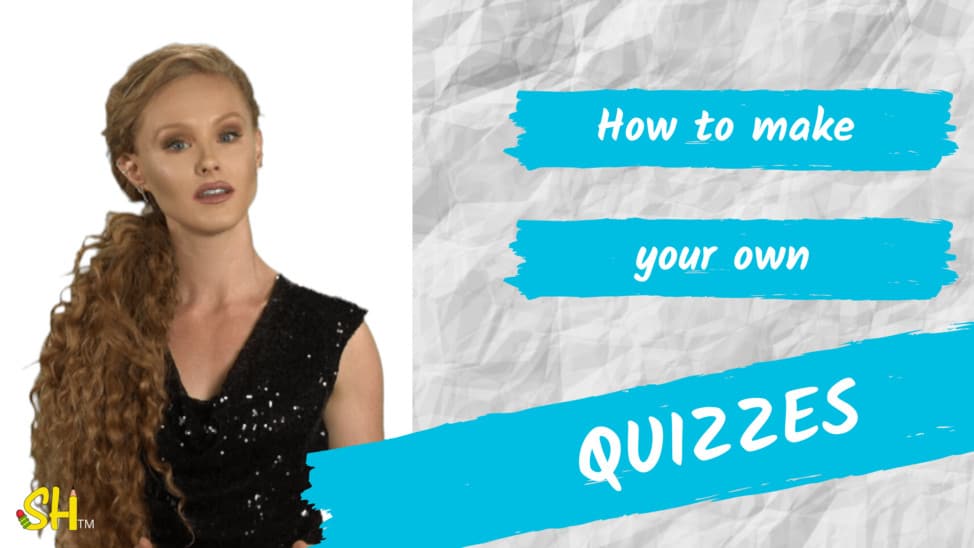By Katie Azevedo, M.Ed.
Let me start with this: The absolute worst way to study is to re-read your notes or your textbook.
Re-reading is not studying. Re-reading is not learning.
Re-reading is just your eyeballs moving over the same stuff it already moved over.
Reading is passive; you’re not doing anything or thinking anything.
Studying involves thinking about the material.
One of the best ways to make sure you’re really thinking about the material, (and not just fooling yourself into thinking you’re thinking about the material) is to quiz yourself on it.
When you learn how to make your own quizzes, you can study for less time, because you’re actually studying the right way: by constantly testing yourself on what you’re supposed to be learning — without the answers in front of you.
By making your own quizzes and testing yourself, you’re ACTIVELY studying. This is a real thing, folks.
How to quiz yourself on the material you’re studying
1. Ask your teacher for old tests from previous years. Make photocopies, and take the test over and over again as part of your study plan.
Some teachers are cool with this, but some are not. Regardless, it’s worth asking. If you can’t get an old test, move on to numbers 2 and 3.
2. Get extra copies of worksheets or problem sets that you already completed in class. Again, make a few copies and answer these questions over and over again. You could also take your own completed worksheets, white-out the answers, and photocopy them to create your own blank versions. Sure, doing it this way is annoying, but you it’s still doable.
3. Add finally, you can make your own quizzes. I’m going to go into how to find or create questions for these quizzes, but here is the general idea.
- Make the quiz. I outline how how to make your own quizzes in the following section.
- Photocopy your quiz multiple times, or print out a bunch of copies if you’re making a digital version (which I recommend).
- Make an answer key. Fill in one of the quizzes with complete and accurate answers, using your notes and textbook to ensure your answers are on point. This will be become your answer key.
- Take the quiz over and over again. Don’t look at your notes, and don’t look at the answer key until the end when you have to correct it. When you do correct it, on each wrong or incomplete answer, fill in the right information on your quiz. Writing out the correct answers will help you remember it for the next time you take the quiz. Each time you take the quiz, you should get better.
How to make your own quiz and what to include on it
You can use paper or go digital to make the quiz. Doesn’t really matter, but I recommend using the computer so that you can easily modify it and/or make copies.
What matters more are the questions you put on it.
1. Use the study questions after each chapter in your textbook. You know, the ones that we all ignore? Use those.
2. Include any vocabulary from the unit. Vocab doesn’t just include words; it also includes people, time periods, events, etc.
You can write your own fill-in-the-blank sentences, you could make a column of words and a column of definitions that you have to match, or you could just list out the terms and require yourself to write out the definitions. Whatever. Here are some hacks for studying vocab.
3. Include any blank diagrams and fill-ins. If your real test is going to ask you to fill in diagrams – like the parts of a plant cell or something – then make sure you include that blank diagram on your quiz. Or maybe you’ll have to fill in a timeline on your test – so make sure you include that blank timeline on your quiz.
If you don’t have a blank diagram handy, then just use Google Images to search for “blank diagram of XX” — you’ll be surprised at what you’ll find! Or, worst-case scenario is that you draw it out yourself.
4. Ask your teacher. Seriously, directly ask what will be on the test. Write down everything she says, and form those into questions on your own quiz that you’re making.
For example, if she says “You’ll need to know four contributing factors to the Great Depression in America,” you would form that into a question like “What were four contributing factors to the Great Depression in America?”
5. Include HOW and WHY questions. Of course your quiz should include questions in terms of who, what, when, and where, but mostly focus on the WHY and HOW questions. Those are the ones that teachers love, because those are the deeper-level questions.
So sure, you might be tested on WHEN World War II started and how long it lasted, but you’ll most likely be tested on WHY did it happen and HOW did it end. Stuff like that.
Final notes on how to make your own quizzes
When in doubt if something is going to be on the test or not, and you don’t know whether to include a question on the quiz that you’re making, you’re better off including it to be safe. Better yet? Ask you teacher.
Also – if your teacher gave you a study guide in advance (which would be amaaazing), then make sure you include everything from the study guide on your own quiz.
Lastly and again, once you’re done making your quiz, just keep taking it over and over again, using your answer key to correct it each time.
Pay attention to the questions that you miss. Study them, and then take the quiz again. Rinse and repeat until you know what you need to know. And use these guidelines here to know when it’s actually time to stop studying.

